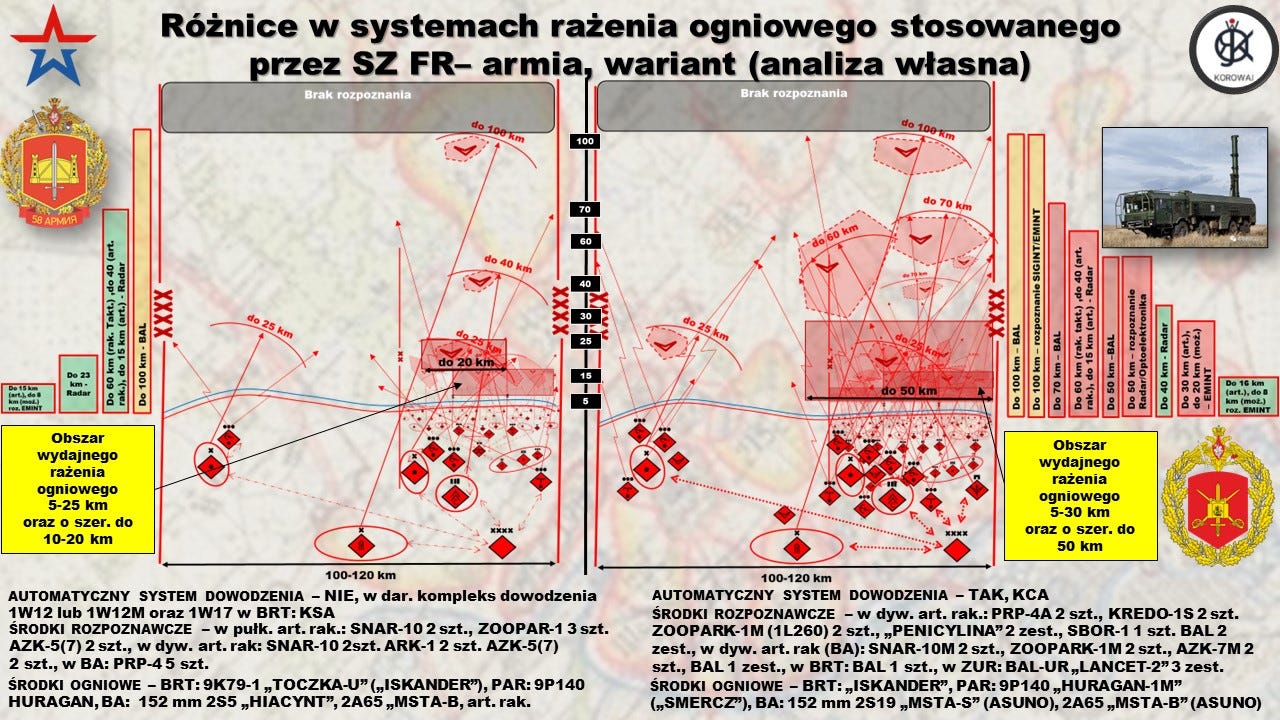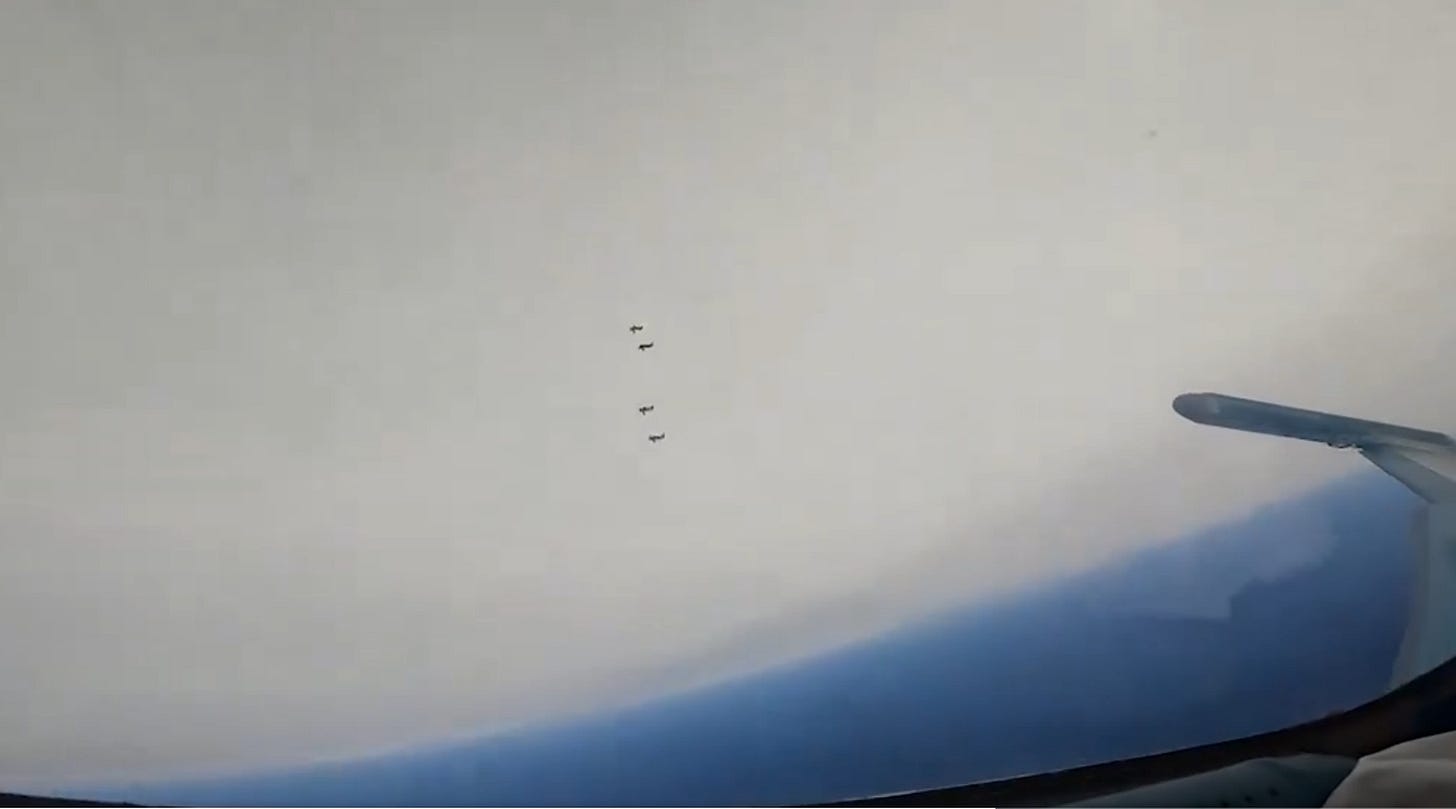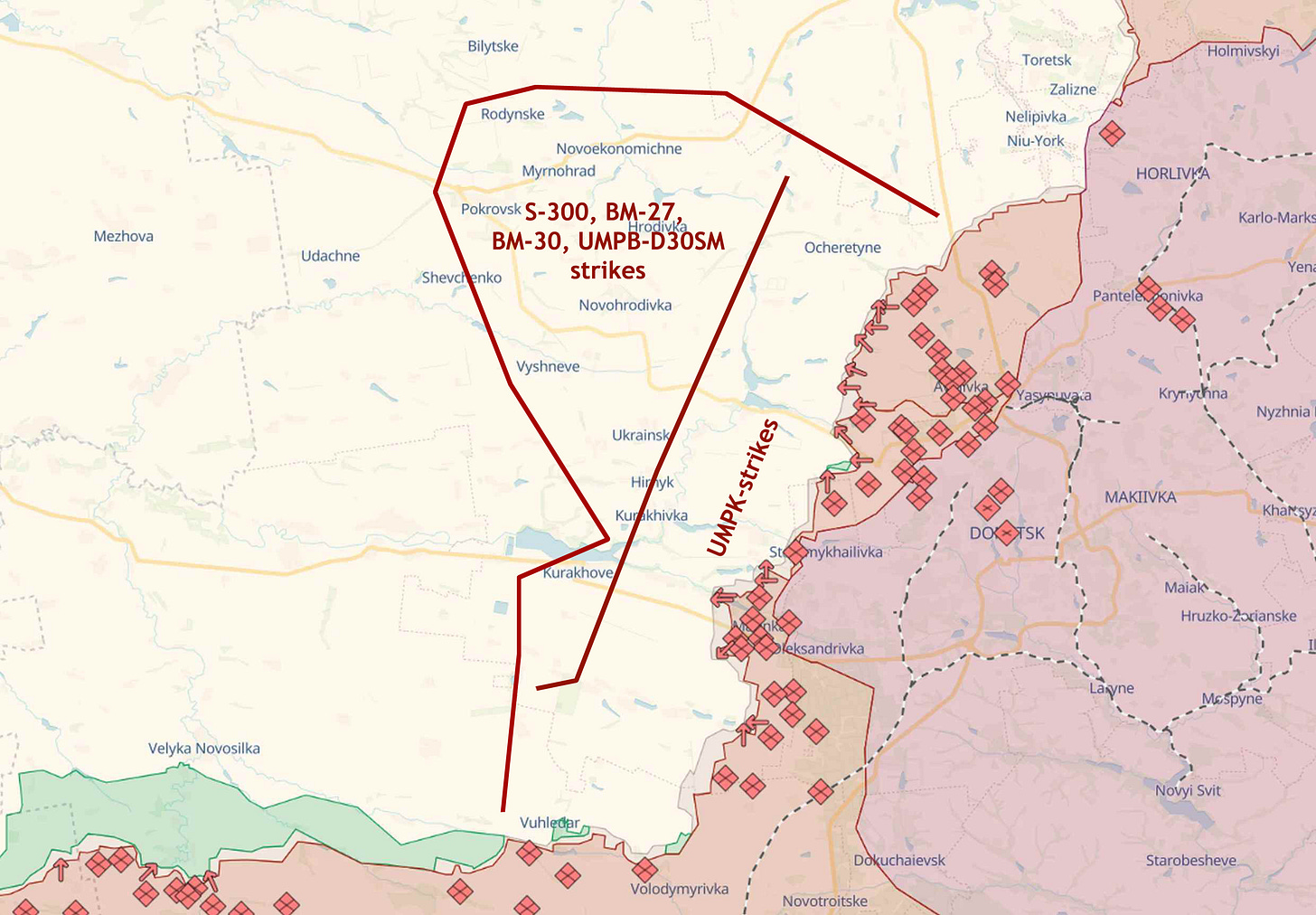Hello everybody!
Originally, this came into being as a sort of a ‘supplement’ to my ‘update’ published earlier today. Then it grew, and grew … until I decided to post it as a separate feature….
The last few weeks, reports and assessments began appearing in the social media according to which the Russian Armed Forces (VSRF) have significantly improved their so-called ‘reconnaissance-strike chain’ - at least on the tactical level.
Accordingly, the Russians have found a way to drastically shorten the time from target detection (usually by UAVs), to actual engagement of that target – and that in the area from 20 to 50km behind the frontline… Something along these lines (appeared in the Polish social media):

Well, I’m that curious SOB… (no, I’m not going to explain that abbreviation in this place)…and then you know that with the itch in my small toe, and my questions…. and so I went to check official releases from Kyiv, plus what can be found in the Ukrainian and the Russian social media (whether civilian- or military-related) about the Russian air strikes on targets, say, ‘more than 20km behind the frontline’ – and that over the last four weeks.
….and I created a list, in chronological order, then checked everything with help of a map etc… and then things started ‘getting together’, and certain other thingies began falling apart…
But, let me explain this step-by-step. Correspondingly:
- 25 February: the Russians hit a RM-70 Vampire system outside Horikhove, (50km north of Vuhledar and 60km west of Avdiivka), probably by Lancet; otherwise, the VKS (the Russian Air-Space Force) spent much of that day UMPK-ing Umanske, Yasnobrodivka, and Netaliove (Avdiivka sector, all 10-15km behind the frontline).
- 26 February: the Russians hit Mykolaivka by BM-27 or BM-30s, plus hit one NASAMS-launcher, about 50km behind the frontline; otherwise, the VKS repeated the exercise from the day before. Only its targets were slightly different: Ocheretyne, Novopokrovske, Netaliove, and Pervomaiske (Avdiivka sector, all 5-10km behind the frontline).
- 27 February: the Russians rocketed Pokrovsk (unsure if by BM-27, BM-30, or S-300s), damaging the local university, school, and 14 private homes (Avdiivka sector, 50km behind the frontline).
- 28 February: the Russians rocketed Pokrovsk by BM-27s or BM-30s again, plus Oleksiivka (40km south of Pokrovsk); VKS was UMPK-ing the Kurakhove area 15-20km behind the frontline.
- 1 March: the Russians have hit a Ukrainian MAN KAT1 truck somewhere north of Oleksiivka (30km west of Mariinka), but the mass of their other efforts were UMPK-strikes on Novooleksandrivka, Arkhanhelske, Ocheretyne and few other places north-west of Avdiivka, all 5-10km behind the frontline.
- 3 March: the Russians deployed S-300s to target Pokrovsk, plus UMPKs to hit Mykolaivka and Myrnohrad, north-east of it. Also, Kurakhove, 30km behind the frontline, was heavily hit by UMPKs that day.
- 5 March: the Russians hit Pokrovsk with S-300s again, plus Novohrodivka (30km behind the frontline) by UMPKs.
- 6 March: the Russians hit Pokrovsk with S-300s; UMPK-strikes were back to remaining limited to the areas immediately behind Ukrainian frontlines north and west of Avdiivka.
- 7 March: the Russians hit Pokrovsk with… not sure, but probably S-300s. VKS continued UMPK-ing the Ocheretyne area.
- 8 March: the Russians targeted Volodymyrivka, Myrnohrad, and Novohrodivka (30-50km behind the frontline) by S-300s, perhaps by BM-27s and/or BM-30s. Otherwise, UMPK-strikes remained ‘limited’ to the area between Novooleksandrihivka-Ocheretyne-Novopokrovske-Prohres (15-20km north-west of Avdiivka).
- 9 March: the Russians caught that supply convoy of the 138th Air Defence Brigade as this stood for too long on a road south-east of Serhiivka, 70km behind the frontline. That said, the mass of their UMPK-strikes and MRLS-fire remained limited to 5-10km behind the frontline.
….and so it went on over the last two weeks, too…
- 10 March: Sviatohorivka (70km from the frontline) and Myrnohrad were hit by S-300s again.
- 15 March: Myrnohrad hit by S-300s but also by two Grom air-launched missiles.
- 16 March: Myrnohrad hit by ‘three rockets’ (type not mentioned). Vyshneve (40km behind the frontline) was hit too.
- 17 March: Selydove was hit by two UMPB-D30SM small diameter bombs.
- 19 March: Selydove hit again – this time by at least one S-300.
- 21 March: Novogrodivka (30km behind the frontline) hit by two UMPB-D30SMs.
- 22 March: Selydove hit by unknown weapons (probably BM-27 or BM-30).
- 23 March: one of eastern outskirts of Myrnohrad was hit by unknown weapons.
….through all this time, the VKS continued UMPK-ing places 5-10km behind the frontline, or plastering ZSU positions along the frontline.
Now, please pay attention, because this is enabling quite a number of deductions.
1.) When one ignores nocturnal strikes by ballistic- and cruise missiles, and Shaheds… all these places hit that are more than 20km behind the frontline, are in the western Donetsk Oblast. None in eastern Kharkiv. None in southern Zaporizhzhya. None in Kherson. On the contrary: the area where the mass of Russian actions more than 20km behind the frontline can be monitored is, actually, ‘geographically limited’ - and that to the sector of the frontline west of Avdiivka and north of Vuhledar. The area, where the Russians have it at easiest in this conflict (because of the proximity to their air bases, the local railway network and thus proximity to their supply depots etc.)
Something like this:
2.) ….which, in turn, is supportive for conclusions explained here, few days ago: Think Russian.
3.) Average range from which the VKS fighter-bombers are deploying their UMPK glide bombs is some 60km. Lately, there are reports about a growing number of releases from 70km away. Given that the majority of these are striking targets either along the frontline, or 5-20km behind it, deduction is possible that the Russians are thus releasing the mass of their UMPKs from around 45-65km short (i.e. east or south) of the frontline (as listed above, air-launched weapons are rarely deployed against targets more than 20km behind the frontline: exception are two Groms launched at Myrnohrad, on 15 March, and Kurakhove and Novohrodivka hit by UMPKs on 3 and 5 March).
Why that?
Because the Russians are seeking for options where their Su-24s and Su-34s are releasing UMPKs from outside the range of Ukrainian SAMs, or from just within 5-10km inside that range - so that their aircraft can release and then quickly turn around, to avoid any possible enemy fire.

4.) In turn, this is enabling the deduction that the mass of Ukrainian ‘heavy’ SAMs (see: NASAMs, IRIS-T, perhaps few Buks) are deployed 20-60km behind (west or north) of the frontline….
5.) …with MIM-104 Patriot systems probably some 50-120km from the frontline (because their missiles have the known range of about 160km: thus, 50-120km to the frontline = effective range 40-110km behind the frontline).
6.) ….which in turn means that recent Russian ‘suppression of enemy air defences’ (SEAD) operations have been successful in so far that they have forced Ukrainians to keep their MIM-104s ‘rather closer to these 120km’ away from the frontline. Which in turn is explaining why after a spate of claimed successes, back in February, the last few weeks the PSU didn’t claim any additional Russian fighter-bombers as shot down:
a) either it is short on MIM-104 missiles, or
b) it was forced into realisation that it can’t safely operate them any closer to the frontline (at least not for extended periods of time).
7.) Yes, of course, the VSRF is trying to introduce its Strelets automated tactical management system into wider use: it’s trying to do that for nearly two years, meanwhile. However, at most, it’s the VSRF Group Tsentr (and VSK units assigned to its support) that’s not so much depending on the Strelets, as something like ‘excelling at smuggling its Orlans and similar stuff’ (read: reconnaissance UAVs) - perhaps some Spetsnaz teams, too - some 20-50km behind the Ukrainian frontlines. And that ‘from time to time’ (say: ‘every second day, on average’). Which is actually no surprise, because the ZSU’s frontlines in the Avdiivka-Shakhtarsk sector remain some of poorest-protected from that kind of threat (UAVs and VKS’ air strikes).
8.) The mass of targets that ‘deep’ behind the frontline are targeted by Iskanders, S-300s (SAMs, fired in ‘ballistic mode’, in which they are notoriously inaccurate), BM-27 and BM-30 multiple rocket-launch systems (with the latter, reportedly, releasing these brand-new UMPB-D30SM small diameter bombs, too).
9.) Not one of targets attacked by the Russians while 20+ kilometres behind the frontline was ‘mobile’ or ‘on the move’. Even that supply convoy of the 138th was ‘fixed in position’. Due to problems in communication, resulting in uncertainty which way to go (i.e. what of firing units to re-supply as next), it remained in same place for three hours.
This might appear a ‘minute’ factor, but is of immense importance.
Indeed, alone this is leading me to the following conclusion: sorry, by all respect for (I’m sure) good intentions - I’m not convinced. Means: nope, so far there is no evidence that the VSRF is significantly improving its Reconnaissance-Strike Chain. Otherwise, there would be similar amounts of similar strikes everywhere else: at least the VKS has enough Su-24s and Su-34s to fly many more strikes with UMPK glide bombs. Yet, it’s not doing that.
I dare going as far as to conclude: the majority of strikes by BM-27s, BM-30s, and S-300s are obviously run ‘on basis of HUMINT’ (stands for ‘human intelligence’, and means: informants in Ukraine).
Regarding the three NASAMS-launchers that were hit the last four weeks: mind that where there is one such launcher, there ‘must’ be at least one of associated RRDL-NII fire-control radars, too. And such radars emit emissions that can be detected by the Russian electronic intelligence (ELINT) gathering (like Su-24MRs, which are regularly deployed the last few weeks, not to talk about numerous ground stations). Only then do the Russian send one or more UAV to the area in question to pin-point the launcher.
….and even then, and although one can argue that ‘attacks of this kind are occurring almost every day’: in grand total, and for the time being, these are ‘rather exceptions than rules’.
If they would be no exceptions, we would see ‘another Ukrainian NASAMS launcher, or another part of the 138th’, or so many other ‘valuable’ ZSU positions, HQs, depots etc. being hit multiple times every day. All along the frontline.
And if not? Well, then we would not get to see anything of that kind, because the ZSU is ah-so-super-good at hiding own losses: then the Russians would hit the ZSU very hard, we would not see that, but: the ZSU couldn’t hold the frontline.





We who read this channel are the privileged. Nobody writing in the newspapers has anything like Tom's ability to analyse this conflict.
Thanks for maybe the most useful report about the topic. Actually you also answered the question that captured my mind for weeks, namely a reason of suspended Patriot shots combo. Honestly if they simply short of missles it is not the worst option, because they can be bought or supplied in perspective. But if Russians created much more effective electronic contr measures, it would be much, much worse. Only SAM that could halt fully VKS Kab offensive would be Typhon with SM 6, but there is enormously small chance of supply in perspective of year or 2.